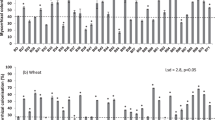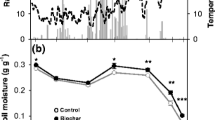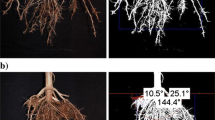Abstract
Aims
Biochar is a carbon-rich product obtained from the pyrolysis of organic materials. Its use, combined with fertilizers, can modify soil properties and affect root morphology and functioning. The main objective of this study was to evaluate the impact of biochar and fertilizer addition on root development and morphology.
Methods
Durum wheat was pot-grown for 2 months using two types of biochar (produced from wheat straw and olive-tree pruning) applied at four rates (0, 0.5, 1 and 2.5 % w/w) and combined with three fertilization levels (0, 40 %-low and 100 %-complete).
Results
Biochar addition at high rates increased the specific root length and decreased both root diameter and root tissue mass density, indicating a fine root proliferation, regardless of the fertilization level. This may have favoured the resource acquisition by increasing biochar-root interactions, soil exploration and the fertilizer efficacy. Biochar addition reduced N and Mn availability but increased P availability, which also influenced root growth.
Conclusions
Changes in root morphology may therefore serve as an important indicator of soil changes induced by biochar and its study can contribute to a better understanding of the effects of the combined application of biochar and fertilizers on plant growth.



Similar content being viewed by others
References
Alburquerque JA, Salazar P, Barrón V, Torrent J, del Campillo MC, Gallardo A, Villar R (2013) Enhanced wheat yield by biochar addition under different mineral fertilization levels. Agron Sustain Dev 33:475–484
Atkinson D (2000) Root characteristics: why and what to measure. In: Pellerin S, Geijn SC (eds) Smit AL, bengough AG, Engels C, noordwijk Nv. Root methods. A handbook. Springer Berlag, New York, pp. 1–32
Atkinson CJ, Fitzgerald JD, Hipps NA (2010) Potential mechanisms for achieving agricultural benefits from biochar application to temperate soils: a review. Plant Soil 33:1–18
Barraclough PB, Kuhlmann H, Weir AH (1989) The effects of prolonged drought and nitrogen-fertilizer on root and shoot growth and water-uptake by winter-wheat. J Agron Crop Sci 163:352–336
Barrow CJ (2012) Biochar: potential for countering land degradation and for improving agriculture. Appl Geogr 34:21–28
Cameron KC, Di HJ, Moir JL (2013) Nitrogen losses from the soil/plant system: a review. Ann Appl Biol 162:145–173
Chan KY, Xu Z (2009) Biochar: nutrient properties and their enhancement. In: Lehmann J, Joseph S (eds) Biochar for environmental management: science and technology. Earthscan, London, pp. 67–84
Chan KY, Zwieten LV, Meszaros I, Downie A, Joseph S (2007) Agronomic values of greenwaste biochar as a soil amendment. Aust J Soil Res 45:629–634
Chintala R, Schumacher TE, McDonald LM, Clay DE, Malo DD, Papiernik SK, Clay SA, Julson JL (2014) Phosphorus sorption and availability from biochars and soil-biochar mixtures. Clean-Soil Air Water 42:626–634
Clough TJ, Condron LM, Kammann C, Müller C (2013) A review of biochar and soil nitrogen dynamics. Agronomy 3:275–293
Comas LH, Eissenstat DM (2009) Patterns in root trait variation among 25 co-existing north American forest species. New Phytol 182:919–928
Conley DJ, Paerl HW, Howarth RW, Boesch DF, Seitzinger SP, Havens KE, Lancelot C, Likens GE (2009) Controlling eutrophication: nitrogen and phosphorus. Science 323:1014–1015
Crane-Droesch A, Abiven S, Jeffery S, Torn MS (2013) Heterogeneous global crop yield response to biochar: a meta-regression analysis. Environ Res Lett 8:44–49
D’Angelo E, Crutchfield J, Vandiviere M (2001) Rapid, sensitive, microscale determination of phosphate in water. J Environ Qual 30:2206–2209
DeLuca TH, MacKenzie MD, Gundale MJ (2009) Biochar effects on soil nutrient transformations. In: Lehmann J, Joseph S (eds) Biochar for environmental management: science and technology. Earthscan, London, pp. 251–270
Diacono M, Montemurro F (2010) Long-term effects of organic amendments on soil fertility. A review. Agron Sustain Dev 30:401–422
Dreccer FM, Schapendonk AHCM, Slafer AG, Rabbinge R (2000) Comparative response of wheat and oilseed rape to nitrogen supply: absorption and utilization efficiency of radiation and nitrogen during the reproductive stages determining yield. Netherlands. Plant Soil 220:189–205
Eissenstat DM (1992) Costs and benefits of constructing roots of small diameter. J Plant Nutr 15:763–782
Eissenstat DM, Wells CE, Yanai RD, Whitbeck JL (2000) Building roots in a changing environment: implications for root longevity. New Phytol 147:33–42
Fitter AH (1985) Functional significance of root morphology and root system architecture. In: Fitter AH, Atkinson D, Read DJ, Usher MB (eds) Ecological interactions in soil. Blackwell Scientific Publications, Oxford, pp. 87–106
Gahoonia TS, Niels NE (2004) Barley genotypes with long root hairs sustain high grain yields in low-P field. Plant Soil 262:55–62
Guerrero-Campo J, Palacio S, Perez-Rontome C, Montserrat-Martí G (2006) Effect of root system morphology on root-sprouting and shoot-rooting abilities in 123 plant species from eroded lands in north-east Spain. Ann Bot 98:439–447
Himmelbauer ML, Loiskandl W, Kastanek F (2004) Estimating length, average diameter and surface area of roots using two different image analysis systems. Plant Soil 260:111–120
Iliffe R (2009) Is the biochar produced by an anila stove likely to be a beneficial soil additive? MSc Diss. UK Biochar Research Centre Working Paper 4
IUSS Working Group WRB (2006) World reference base for soil resources 2006- A framework for international classification, correlation and communication. World Soil Resources Reports 103, FAO, Rome
Jeffery S, Bezemer TM, Cornelissen G, Kuyper TW, Lehmann J, Mommer L, Sohi SP, van de Voorde TFJ, Wardle DA, Van Groenigen JW (2015) The way forward in biochar research: targeting trade-offs between the potential wins. Glob Chang Biol 7:1–13
Jones JB, Wolf B, Mills HA (1991) Plant analysis handbook. A practical sampling, preparation, analysis, and interpretation guide. Micro-Macro Publishing, Athens, USA
Knowles OA, Robinson BH, Contangelo A, Clucas L (2011) Biochar for the mitigation of nitrate leaching from soil amended with biosolids. Sci Total Environ 409:3206–3210
Laird D, Fleming P, Wang B, Horton R, Karlen D (2010) Biochar impact on nutrient leaching from a Midwestern agricultural soil. Geoderma 158:436–442
Lal R (2015) Restoring soil quality to mitigate soil degradation. Sustainability 7:5875–5895
Lehmann J, da Silva JP, Steiner C, Nehls T, Zech W, Glaser B (2003) Nutrient availability and leaching in an archaeological anthrosol and a ferralsol of the central Amazon Basin: fertilizer, manure and charcoal amendments. Plant Soil 249:343–357
Lehmann J, Joseph S (2009) Biochar for environmental management: an introduction. In: Lehmann J, Joseph S (eds) Biochar for environmental management: science and technology. Earthscan, London, pp. 1–12
Liang B, Lehmann J, Solomon D, Kinyangi J, Grossman J, O’Neill B, Skjemstad JO, Thies J, Luizao FJ, Petersen J, Neves EG (2006) Black carbon increases cation exchange capacity in soils. Soil Sci Soc Am J 70:1719–1730
Lorenz K, Lal R (2014) Biochar application to soil for climate change mitigation by soil organic carbon sequestration. J Plant Nutr Soil Sci 177:651–670
Mengel K, Kosegarten H, Kirkby EA, Appel T (2001) Principles of plant nutrition. Kluwer, Dordrecht, The Netherlands
Mukherjee A, Zimmerman AR (2013) Organic carbon and nutrient release from a range of laboratory-produced biochars and biochar–soil mixtures. Geoderma 193:122–130
Mukherjee A, Lal R (2014) The biochar dilemma. Soil Res 52:217–230
Olmo M, Alburquerque JA, Barrón V, del Campillo MC, Gallardo A, Fuentes M, Villar R (2014a) Wheat growth and yield responses to biochar addition under Mediterranean climate conditions. Biol Fertil Soils 50:1177–1187
Olmo M, Lopez-Iglesias B, Villar R (2014b) Drought changes the structure and elemental composition of very fine roots in seedlings of ten woody tree species. Implications for a drier climate. Plant Soil 384:113–129
Ostonen I, Püttsepp Ü, Biel C, Alberton O, Bakker MR, Lõhmus K, Majdi H, Metcalfe D, Olsthoorn AFM, Pronk A, Vanguelova E, Weih M, Brunner I (2007) Specific root length as an indicator of environmental change. Plant Biosyst 141:426–442
Prendergast-Miller MT, Duvall M, Sohi SP (2011) Localisation of nitrate in the rhizosphere of biochar-amended soils. Soil Biol Biochem 43:2243–2246
Prendergast-Miller MT, Duvall M, Sohi SP (2014) Biochar–root interactions are mediated by biochar nutrient content and impacts on soil nutrient availability. Eur J Soil Sci 65:173–185
Qian P, Schoenau JJ (2002) Practical applications of ion exchange resins in agricultural and environmental soil research. Can J Soil Sci 82:9–21
Ryser P, Lambers H (1995) Root and leaf attributes accounting for the performance of fast-and slow-growing grasses at different nutrient supply. Plant Soil 170:251–265
Ryser P (1998) Intra–and interspecific variation in root length, root turnover and the underlying parameters. In: Lambers H, Poorter H, van Vuuren MMI (eds) Variation in plant growth. Backhuys Publishers, Leiden, pp. 441–465
Schimmelpfennig S, Glaser B (2012) One step forward toward characterization: some important material properties to distinguish biochars. J Environ Qual 41:1001–1013
Schulz H, Glaser B (2012) Effects of biochar compared to organic and inorganic fertilizers on soil quality and plant growth in a greenhouse experiment. J Plant Nutr Soil Sci 175:410–422
Tilman D, Cassman KG, Matson PA, Naylor R, Polasky S (2002) Agricultural sustainability and intensive production practices. Nature 418:671–677
Valenzuela-Estrada LR, Vera-Caraballo V, Eissenstat DM (2008) Root anatomy, morphology, and longevity among root orders in Vaccinium corymbosum (Ericaceae). Am J Bot 95:1506–1514
Wahl S, Ryser P (2000) Root tissue structure is linked to ecological strategies of grasses. New Phytol 148:459–471
Zheng H, Wang Z, Deng X, Herbert S, Xing B (2013) Impacts of adding biochar on nitrogen retention and bioavailability in agricultural soil. Geoderma 206:32–39
Acknowledgments
This research was funded by the Spanish “Ministerio de Ciencia e Innovación” (Programa Nacional de Cooperación Público-Privada, Subprograma INNPACTO) and FEDER Funds “Fondo Europeo de Desarrollo Regional, una manera de hacer Europa” in the framework of the project “Proyecto Biocar: Estudio del Biocarbón como Sumidero de Carbono” (IPT-440000-2010-8). Thanks to V. Barrón for his comments aimed at improving the manuscript and to J. Torrent, M.C. del Campillo, A. Gallardo, L. Gómez and A. Serrano for their contribution to the project development. We also thank to the reviewers for their helpful comments and suggestions which led to substantial improvements in the manuscript.
Compliance with ethical standards
This article does not contain any studies with human or animal subjects.
Conflict of interest
The authors declare that they do not have conflicts of interest.
Author information
Authors and Affiliations
Corresponding author
Additional information
Responsible Editor: Simon Jeffery.
Electronic supplementary material
ESM 1
(DOCX 553 kb)
Rights and permissions
About this article
Cite this article
Olmo, M., Villar, R., Salazar, P. et al. Changes in soil nutrient availability explain biochar’s impact on wheat root development. Plant Soil 399, 333–343 (2016). https://doi.org/10.1007/s11104-015-2700-5
Received:
Accepted:
Published:
Issue Date:
DOI: https://doi.org/10.1007/s11104-015-2700-5




